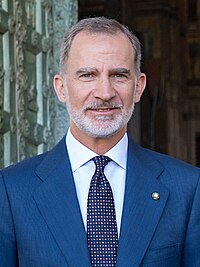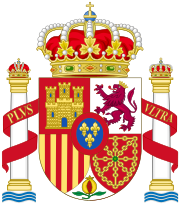
Back الملكية في إسبانيا Arabic Monarkiya kan Espanya BCL Španělská monarchie Czech Spanische Monarchie German Μοναρχία της Ισπανίας Greek Monarkio de Hispanio Esperanto Monarquía Española Spanish Hispaania kuningas Estonian پادشاهی اسپانیا Persian Espanjan hallitsija Finnish
| King of Spain | |
|---|---|
| Spanish: Rey de España | |
 | |
| Incumbent | |
 | |
| Felipe VI since 19 June 2014 | |
| Details | |
| Style | His Majesty |
| Heir presumptive | Leonor, Princess of Asturias |
| First monarch | Isabella I of Castile and Ferdinand II of Aragon (Catholic Monarchs of Spain) |
| Residence | Royal Palace of Madrid (official) Palace of Zarzuela (private) |
| Website | The Spanish Monarchy |
 |
|---|
The monarchy of Spain or Spanish monarchy (Spanish: Monarquía Española) is the constitutional form of government of Spain. It consists of a hereditary monarch that reigns as the head of state, being the highest office of the country.[1] The current King is Felipe VI since 19 June 2014, after the abdication of his father, King Juan Carlos I.
The Spanish monarchy is constitutionally referred to as The Crown (Spanish: La Corona), and it comprises the reigning monarch, his or her royal family, and the Royal Household, which supports and facilitates the sovereign in the exercise of his duties and prerogatives.[2][3] The Royal Family is currently represented by King Felipe VI, Queen Letizia, their daughters Leonor, Princess of Asturias, and Infanta Sofía, and the king's parents, King Juan Carlos and Queen Sofía.
The Spanish Constitution of 1978 re-established[1][note 1] a constitutional monarchy as the form of government for Spain after the end of the dictatorship of Francisco Franco and the restoration of democracy in 1977. The 1978 constitution affirmed the role of the King of Spain as the living personification and embodiment of the Spanish nation and a symbol of Spain's enduring unity and permanence and is also invested as the "arbitrator and the moderator" of Spanish institutions.[2][4] Constitutionally, the sovereign is the head of state and commander-in-chief of the Spanish Armed Forces.[2][4] The constitution codifies the use of royal styles and titulary, royal prerogatives, hereditary succession to the crown, compensation, and a regency-guardianship contingency in cases of the monarch's minority or incapacitation.[2][4] According to the Constitution, the monarch is also instrumental in promoting relations with the "nations of its historical community".[2][4] The monarch serves as honorary president of the Organization of Ibero-American States, representing over 700,000,000 people in twenty-four member nations worldwide.[5][6] Spain and Monaco are the last remaining monarchies on the European Mediterranean coast.
The Spanish monarchy has its roots in the Visigothic Kingdom of Toledo founded after the fall of the Western Roman Empire. Then, the Kingdom of Asturias fought the Reconquista following the Umayyad conquest of Hispania in the 8th century. A dynastic marriage between Isabella I of Castile and Ferdinand II of Aragon (the "Catholic Monarchs") united Spain in the 15th century. The Spanish Empire became one of the first global powers as Isabella and Ferdinand funded Christopher Columbus's exploratory voyage across the Atlantic Ocean. The sea route he established paved the way for the Spanish conquest of much of the Americas.
As of 2023, the official budget for the Spanish monarchy is 8.4 million euros, one of the lowest public expenditures for the institution of monarchy in Europe.[7] However, other expenses of the royal house are assumed by different government departments.
- ^ a b Powell, Charles. Juan Carlos of Spain; Self Made Monarch. St. Martin's Press, Inc.
- ^ a b c d e "Título II. De la Corona, Wikisource". Archived from the original on 12 November 2020. Retrieved 27 May 2009.
- ^ Constitution of Spain 1978, Title II, Article 56, Subsection 2 and amended by Royal Decree 1368/1987, dated 6 November.
- ^ a b c d Title II, Article 56, Subsection 1.
- ^ Cite error: The named reference
Spanish King rebrands for recessionwas invoked but never defined (see the help page). - ^ "Uribe is the Ibero-American leader best valued by the citizens of his country" [Uribe is the Ibero-American leader best valued by the citizens of his country]. El Mundo (in Spanish). 7 October 2008. Archived from the original on 13 December 2020. Retrieved 1 December 2009.
- ^ RTVE.es (6 October 2022). "La Casa Real mantiene congelado su presupuesto para 2023". RTVE.es (in Spanish). Retrieved 27 November 2023.
Cite error: There are <ref group=note> tags on this page, but the references will not show without a {{reflist|group=note}} template (see the help page).
© MMXXIII Rich X Search. We shall prevail. All rights reserved. Rich X Search